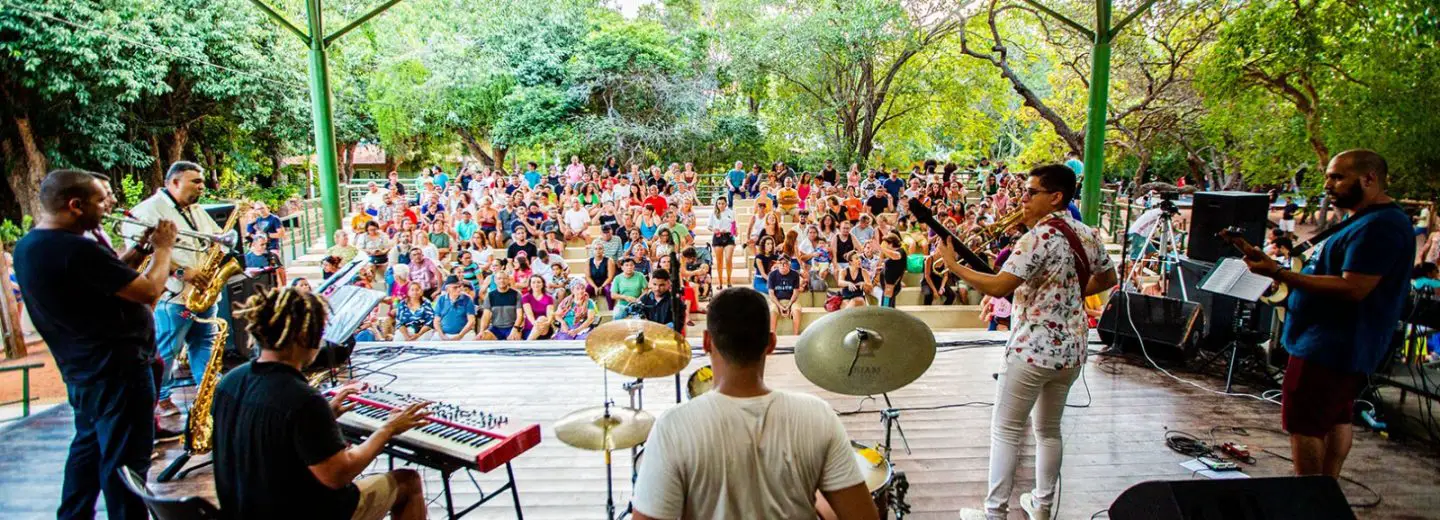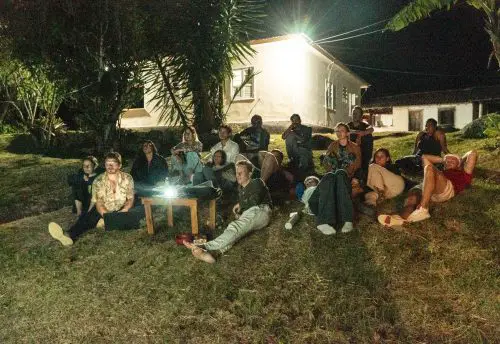
Habitable and Edible: Revitalizing Forests Is Returning Life to Cities
Many believe cities have little room for ecological solutions, but these ongoing initiatives prove otherwise— they are transforming urban spaces into thriving, edible, and habitable ecosystems. In cities, concrete often overshadows the green. However, as climate challenges emerge, urban areas are reimagining their relationship with nature. In this article we list some initiatives from the personal to the international cooperation level that are reconnecting the dots and giving new meanings to habitating sustainably.
We live in times when cities persist in distancing themselves from the forest, forgetting that they once sprang from its generous embrace. In the past, streets ran alongside rivers and houses peeked out among ipê trees, ingás and araçá trees, like discreet flowers in a corner. It’s easy to close your eyes and long for shaded streets, flavorful plazas, living parks, cultural gatherings and places where regeneration happens every day.
Creating this vision isn’t about returning to the past; it’s about putting humanity’s finest skills at the service of our species’ well-being. That vision already blooms quietly in well-designed architectural projects: homes turned into green refuges, corridors of mango and cashew trees that link neighborhoods, and urban parks celebrated as sanctuaries of the Atlantic Forest. Every planned or regenerated backyard becomes a living laboratory for testing gentle ways of inhabiting the Earth.
The proposal below invites you to reinvent your relationship with city and nature. Inspired by Marshall Sahlins’s concept of “original affluence” and Erich Fromm’s warnings, it shows that our choice is clear: destroy or regenerate. By opting for the work of care, we naturally become gardeners of the new forest.
1. Everyday Agroforestry: Evolution from Backyards to Balconies
The great ecological transformation begins at the scale of daily affection and care. Integrating small agroforestry systems into our homes—whether in yards or pots—is the first step toward weaving a new relationship with food and soil.
- Forest-mimicking polycultures
Try growing beloved Brazilian species side by side. A cashew tree (Anacardium occidentale), a national symbol, offers shade and fruit. Beside it, a passion fruit vine (Passiflora edulis) grows quickly, has a calming effect and attracts butterflies and bees. In partial shade, lemon verbena (Lippia alba) perfumes the air and yields soothing teas. - Closing the cycle with composting
Kitchen scraps, dry leaves and garden prunings can be transformed into rich humus, returning fertility to the soil that feeds our table while reducing urban waste. - Small steps, sustainable benefits
Plant a native tree this week. Observe and record which visitors it attracts—butterflies, birds, small bees—and then celebrate by inviting neighbors to a picnic featuring recipes from your garden. Each gesture is a link in the green network reconnecting Brazil’s biomes.
2. Architecture for Wildlife: Shelters for All Beings
Regenerating the city also means inviting wildlife back in. Designing spaces that welcome other species heals urban loneliness and strengthens the ecosystem we belong to.
- Shelters and nests
Install birdhouses for sabiás, insect hotels and shelters for stingless native bees (mandaçaia, jataí). They are the major pollinators of your neighborhood. - Water is life
Small water mirrors or fountains attract birds, amphibians and dragonflies, creating a biodiversity soundtrack and helping to control mosquitoes. - Resilient gardens
Prioritize native species adapted to the local climate—they need less water and irrigation and provide food and shelter for wildlife. A garden with pitanga and bromeliads in Rio de Janeiro or cashew and catingueira trees in Natal is an invitation to resilience.
3. Regeneration Trails: Tourism and Community Engagement
Tourism can be a powerful tool for transformation, leaving a legacy of roots and knowledge. Collective engagement amplifies the impact of each individual action, turning admiration for nature into active care.
- Join planting brigades
As a visitor or resident, sow the forest with your own hands. Many initiatives, like Eco Caminhos in Nova Friburgo (RJ), welcome volunteers. - Citizen science and bioeconomy
Use apps to record birds and trees, contributing to protection policies. Discover local bioeconomy workshops, from culinary uses of unconventional edible plants (PANCs) to essential-oil distillation. - The power of the collective
Gather three friends and visit a local initiative. Document the work—whether restoring a degraded area or producing food—and choose multi-day programs for a true immersion. A small group can balance skills, make decisions and celebrate achievements, planting forests no one could create alone.
4. Living Parks: Community Convergence Points
Urban parks are the lungs and social heart of cities. There, conservation, culture and leisure walk hand in hand, proving that the forest survives when it’s part of people’s routine. Below are examples that illustrate this potential.
| City/Region (State) | Park/Initiative | Notable Regenerative Actions | Benefits for the City and Community |
|---|---|---|---|
| Natal (RN) | Parque das Dunas | Preservation of 1,172 ha of Atlantic Forest; “Sound of the Forest” concerts; guided trails; craft fairs; open-air dance. | Protection of a vital ecosystem; leisure, culture and environmental education for metropolitan residents. |
| Natal (RN) | Parque da Cidade Dom Nivaldo Monte | Ecological trails; community gardens; library; environmental education for schools. | Community integration with nature; local food production; ecological awareness. |
| Nova Friburgo (RJ) | Eco Caminhos | Over 8,000 trees planted; agroforestry systems supporting entire families. | Strengthening of sustainable, family-based agriculture. |
| Nova Friburgo (RJ) | Instituto Araçá | Participatory research; regenerative tourism routes; citizen science. | Community engagement in conservation; generation of local knowledge. |
| Rio de Janeiro (RJ) | Parque Nacional da Tijuca | Maintenance of the world’s largest replanted urban forest (3,953 ha); volunteer reforestation programs. | Climate regulation; watershed protection; ecological tourism; leisure for millions. |
| Rio de Janeiro (RJ) | Parque Estadual dos Três Picos | Connection of Atlantic Forest fragments; protection of threatened species; long-distance trails; environmental education. | Creation of ecological corridors; promotion of ecotourism; biodiversity conservation. |
| Rio de Janeiro (RJ) | Parque da Cidade | Well-preserved refuge in Gávea with leisure areas for families. | Picnic spots and trails near the Moreira Salles Institute. |
| Porto Alegre (RS) | Parque Estadual de Itapuã | Preservation of 5,566 ha in the Pampa–Atlantic Forest transition; over 700 cataloged plant species. | Protection of a rare transition ecosystem and its biodiversity. |
| Derrubadas (RS) | Parque Estadual do Turvo | Preservation of 17,491 ha of Atlantic Forest; home to 42 % of Rio Grande do Sul’s mammal species. | Protection of a biodiversity hotspot, including endangered species. |
| Florianópolis (SC) | Parque Municipal da Lagoa do Peri | Protection of 2,030 ha and the island’s only freshwater reservoir; interpretive trails. | Water security for the island; conservation; leisure. |
| Blumenau (SC) | Parque Nacional da Serra do Itajaí | Protection of Santa Catarina’s largest continuous Atlantic Forest remnant (57,374 ha). | Large-scale biome conservation and associated ecosystem services. |
| Zona da Mata (MG) | Centro de Tecnologias Alternativas (CTA-ZM) | Promotion of agroecology; spring restoration; implementation of agroforestry systems. | Strengthening of family farming; water security; sustainable income generation. |
Brazil’s biomes are not just memory; they are promise. It is up to us, urban gardeners, to evolve from distracted consumers into attentive guardians. Backyard by backyard, friendship by friendship, choice by choice, we are stitching the forest back into the heart of our cities.
![[:en]Eco Caminhos: Permaculture & Agroforestry Farm in Brazil[:br]Eco Caminhos: Fazenda de Permacultura e Agrofloresta no Brasil[:sp]Permacultura y Agroforestería en Brasil: Eco Caminhos[:]](https://ecocaminhos.com/wp-content/uploads/2024/02/Eco-Caminhos-logo-without-border.png)

 Português
Português Español
Español

